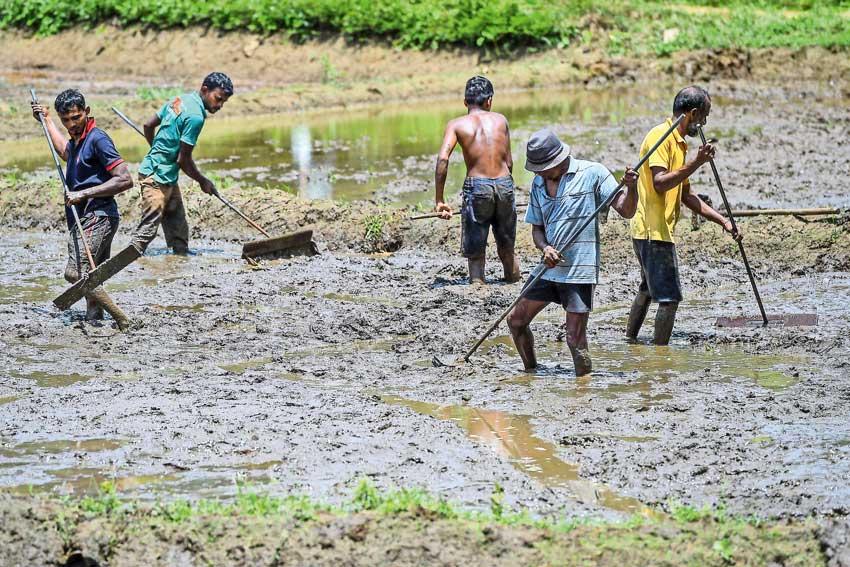Reply To:
Name - Reply Comment

South Asia’s rural landscape has been profoundly reshaped by such ‘reforms’, dispossessing farmers of their land, and pushing them into wage labour and migration as coping mechanisms (pic AFP)
 Those familiar with the systematic attack on agriculture in South Asia over the last decades will not be surprised at the ongoing farmers’ protests in India. It could have been Pakistan, where farmers protesting for support prices were beaten up and arrested in Lahore only a month ago, or Sri Lanka, where shortages of imported fertilizers and declining subsidies has led to farmers’ outcry. In the middle of a long simmering rural economic crisis pushed over the cliff by the COVID-19 pandemic, efforts by South Asian governments to project corporatisation and deregulation as the way forward for agriculture have angered long-suffering farmers.
Those familiar with the systematic attack on agriculture in South Asia over the last decades will not be surprised at the ongoing farmers’ protests in India. It could have been Pakistan, where farmers protesting for support prices were beaten up and arrested in Lahore only a month ago, or Sri Lanka, where shortages of imported fertilizers and declining subsidies has led to farmers’ outcry. In the middle of a long simmering rural economic crisis pushed over the cliff by the COVID-19 pandemic, efforts by South Asian governments to project corporatisation and deregulation as the way forward for agriculture have angered long-suffering farmers.
Contempt for small-holding producers has been a part and parcel of policy-making across the region for decades. Successive governments have imposed a corporate agenda, seeking profits from food production and distribution by relaxing norms for cheap food imports, and encouraging export-oriented production, price speculation, agribusiness and retail supermarkets. South Asia’s rural landscape has been profoundly reshaped by such ‘reforms’, dispossessing farmers of their land, and pushing them into wage labour and migration as coping mechanisms. This hollowing out of rural livelihoods does not come with any assurance of stable jobs or a decent quality of life in urban areas.
Pandemic opportunism
The COVID-19 crisis has given a new lease of life to such efforts. India is not the only country to have attempted to seize this moment to deregulate agricultural markets. In Pakistan, at the height of the first lockdown in May this year, the government inked an agreement with the World Bank to further deregulate the country’s wheat market. In Sri Lanka, with the national budget just passed for 2021, there are only meagre allocations towards revitalising agricultural livelihoods and policies focused on supporting technologies suitable for agribusinesses. Instead of the current crisis sending governments back to the drawing board, South Asia’s authoritarian regimes, complicit with corporate interests, are railroading in anti-farmer agricultural policies.
Corporate agriculture further exacerbates the existential danger faced by South Asian farmers. Such corporate solutions do not address the role of middlemen and traders in denying farmers a fair price for their labour. Instead, opening up markets to large corporations is likely to spark the same sort of race to the bottom that has been seen in the industrial and service sectors. Deregulation makes farmers’ livelihoods even more precarious and threatens food sovereignty through increased dependence on global agricultural trade. It has become far too easy to forget that it was the collapse of global agricultural commodity prices in the 1970s that had a large role to play in the debt crisis that haunts countries such as Pakistan and Sri Lanka.
Reviving resistance
There is a powerful legacy of rural movements in South Asia that have fought for the rights of farmers, peasants and agricultural workers. Rural movements played a crucial role in the anti-colonial struggle and fought for progressive land and agrarian reform after Independence. Seventy years on, they continue to fight against the recent waves of anti-farmer policies, while advancing new progressive visions such as peasant agroecology and food sovereignty, which put small food producers and the environment at the centre.
While the issues highlighted by the Indian protests are not entirely new, the current convergence of authoritarianism and corporate capital brings this existential crisis for rural agricultural producers even more sharply in focus. Farmers’ movements have been aware of state connivance with exploitative actors, but they must now also contend with a breakdown of democratic process and increased repression. Those in power seem to have been caught off guard by the songs and displays of solidarity in Delhi and many other parts of India over the past two weeks. Just when it seemed like the anti-Citizenship (Amendment) Act protests against the Bharatiya Janata Party’s Hindutva agenda had been suppressed by severe state violence, the farmers’ movement has become the new face of opposition to the Narendra Modi government. These should be ominous signs for regimes across South Asia which continue to act with impunity in the face of demands for economic and social justice.
Voices of movements
The COVID-19 pandemic has pushed food sovereignty back into the public imagination. We have been reminded of how precarious our food supplies are. The solution, of course, only begins with making farming a viable livelihood. Dominant assumptions about inevitable rural-urban migration and techno-utopian transformation in agriculture must be challenged. Questions of land redistribution and other rural inequalities must remain a crucial part of the political agenda.
The situation of mostly female agricultural workers, the rural landless and Dalits in South Asia remains precarious. Even as rural movements across South Asia fight the ongoing attack on their livelihoods, they must also tackle rural inequality head on.
The air is ripe for new visions of rural emancipation in South Asia. Rural movements are working to transform not just their world but are becoming catalysts for a broader anti-authoritarian struggle in South Asia. The rural movements that swept across South Asia in the 1960s may seem like a distant memory. The current phase of struggles has revived old questions, while raising others about the future of our long ignored rural world.
We must listen to the voices and demands of the rural movements converging across South Asia.
(Hashim bin Rashid is doing his PhD at SOAS, London, Amod Shah, doctoral candidate at ISS, Hague, and Ahilan Kadirgamar is a Senior Lecturer, University of Jaffna.
A version of this article was published in The Hindu)